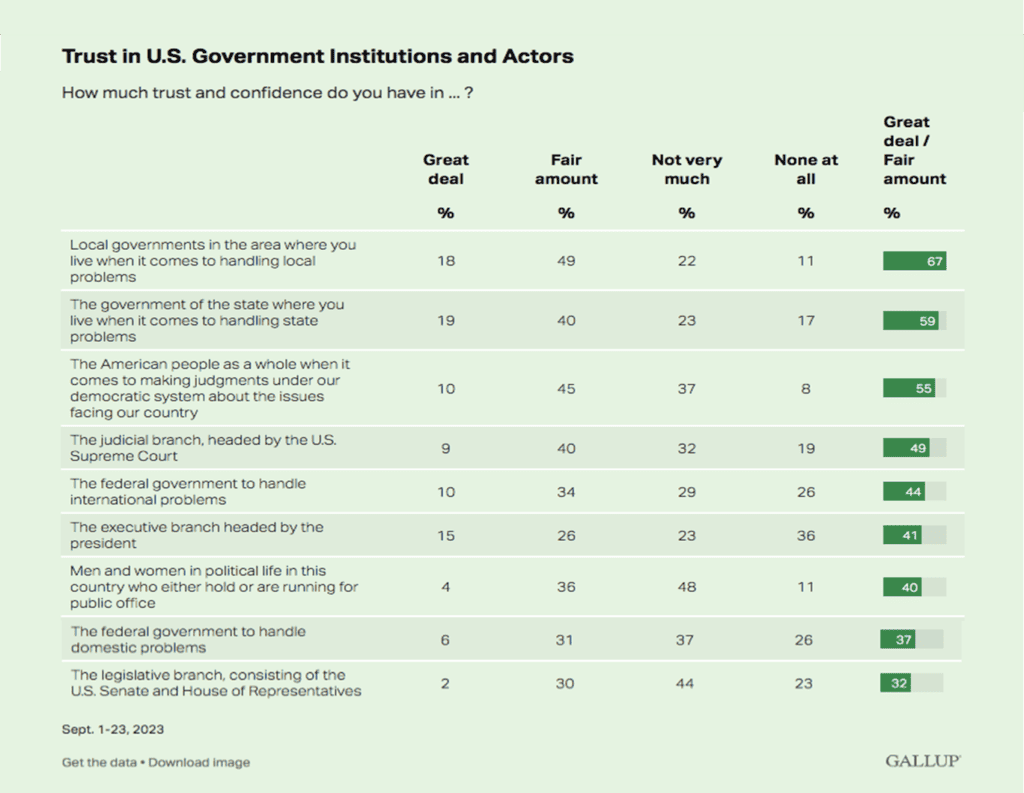Human Resources in 2024
HR IN 2024: A MULTI-LEVEL U.S. GOVERNMENT ANALYSIS
Welcome to SIGMA’s 2024 report on the state of human resources (HR) in the United States (U.S.) government. Our aim with this report is to present an accurate and comprehensive depiction of the current trends, challenges, and opportunities within the federal, state, and local government workforce. We will explore prevailing trends, underscore crucial needs, and suggest actionable steps for organizations aspiring to enhance their talent management systems.
It is our hope that this report serves as a valuable resource for your leadership and contributes to the improvement of HR practices in your organization.

PREVIEW: INTRODUCTION
“Government exists for the interests of the governed, not for the governors.”
Thomas Jefferson, third president of the U.S.
Governmental operations are frequently trivialized through simplistic depictions in media and public discourse. However, beyond these superficial representations lies a complex and historically significant entity, fundamental to the prosperity of nations, states, and municipalities. The government of the United States is one of the largest in the world, employing more than 4 million people to help establish and enforce the law, steward taxes, maintain roads and bridges, regulate the economy, and more.1 This underscores its profound significance and influence. The effectiveness of such a vast entity hinges on its workforce, highlighting the critical role of human resources management in ensuring operational excellence and strategic success.
Focusing on Local Governments
This report, while addressing federal issues, primarily concentrates on local governmental trends and practices. Local governments, in contrast to their federal counterparts, have more dynamic and accessible human resources, which makes it easier to collect data, perform causal analyses, and implement change. Our objective is to identify and establish trends from a grassroots perspective, offering insights and recommendations that are more directly relevant and applicable to the immediate operational environments of local governments. This approach is intended to provide actionable insights that are more tailored to the nuanced needs and structures at the local level, rather than the broader and often less specific context of federal organizations.
The Importance of HR in Government
In 2023, a shared challenge across federal, state, and local governments was the pressing need to expand their workforce. All levels of the U.S. government reported staffing shortages, a situation exacerbated by the effort to regain pre-pandemic staffing levels. Although private sector organizations have largely succeeded in rebuilding their workforce, the public sector continues to face significant recruitment and retention challenges. The importance of human resources in government operations becomes evident here. HR is not merely about filling positions; it ensures that staff are equipped to capably perform their roles and are aligned with the government’s goals. This is essential for government functions to be carried out effectively and efficiently. Therefore, governments must be allocated both budget and time in order to build a strong and sustainable team. Studies have shown that government staffing shortages directly impact public safety, public health, and other important departments.2 These findings reinforce the undeniable importance of both government functionality and the strategic management of human resources within it.
A Note on Trust in Local Government Institutions
Underscoring the importance of local government, a recent Pew Research Center survey revealed a notable disparity in public trust: only 37% of Americans expressed trust in the federal government’s management of domestic affairs, compared to 67% who trusted local governments to manage local affairs.3 This discrepancy underscores the critical role of trust in the successful implementation of strategies. It suggests that trends and initiatives at the local government level are more aligned with public sentiment and are therefore more likely to garner community support and engagement. This insight emphasizes the importance of focusing on local governance as a more direct and trusted mediator of public policy and administration.

Figure 1. 2023 results of Gallup’s annual survey of trust in government institutions and actors.
A Brief History of HR4
The HR profession in America has evolved dramatically over the last century. Prior to the Industrial Revolution, HR did not exist as a formal discipline and administrative tasks related to personnel were performed by individuals in other management roles. During the first half of the 20th century organizations grew dramatically, and the labor market did too. This period saw unprecedented increases in business output and workforce size, but it was also often marked by poor labor conditions. In response, the federal government enacted laws like the National Labor Relations Act and the Fair Labor Standards Act, offering employees certain rights and protections. This was HR as we now know it today, in its nascent form.
Post-World War II, as the American economy continued to grow, new programs such as healthcare benefits and employee pension plans were implemented for employees. Additionally, a new wave of labor legislation was passed, including the Civil Rights Act (Title VII), the Equal Pay Act, the Employee Retirement Income Security Act. These programs and laws resulted in the personnel department being firmly established as an administrative function in American businesses.
By the end of the 20th century, the personnel department had evolved into the “human resources department,” a regulated profession requiring certifications, exams, and membership in national associations. The turn of the century brought rapid technological advancements, introducing Human Resource Management (HRM) systems, mobile technology, and crowdsourcing. Today, HR’s scope is expanding to encompass wellness programs and social events, with increasing demand for these benefits as new generations age into the workforce.
Over the last century, HR has proven itself to be a dynamic function that has evolved to facilitate major economic growth and development. And it will continue to do so. With innovative systems and strategies, HR professionals are equipped to lead in talent management and development, ensuring sustainable operations and successful leadership.
PREVIEW: CHAPTER 1
“Knowing where you are going is the first step to getting there.”
Kenneth H. Blanchard, American author and business professional
To accurately evaluate the current landscape of human resources within U.S. government, it is essential to adopt an analytical approach, harnessing insights from key resources. In this chapter we will analyze data from sources such as the Federal Employee Viewpoint Survey (FEVS), to provide a reliable review of the current state of HR in U.S. government. This method is a practical and effective way to identify and address the multifaceted HR challenges across federal, state, and local government sectors as we enter 2024.
Federal Government Workforce Analysis
Every year, the U.S. Office of Personnel Management (OPM) administers the Federal Employee Viewpoint Survey (FEVS), a comprehensive survey designed to assess various aspects of federal employment. This survey is conducted to gather feedback from federal employees on leadership, development opportunities, succession planning, and other talent management matters. Results of the survey are used to gauge how employees experience policies, practices, and procedures in their organization, and identify areas where improvements are needed for more effective government functioning. 5
In 2023, the FEVS received 625,568 responses. Results showed that while performance is generally strong, there is room for improvement when it comes to job satisfaction, diversity, equity, inclusion, and accessibility, and talent management systems.
Performance Confidence Index
The performance confidence index measures “the extent to which employees believe their organization has an outstanding competitive future.” The index includes items that assess customer satisfaction, quality of work, ability to adapt to changing priorities, goal achievement, and positive contributions to the organization’s performance overall.6 The performance confidence index was a new measure introduced to the FEVS three years ago,7 with the first measure being taken in 2021, and the two subsequent measures having shown relatively stable results since (86%, 85%, and 84% in 2021, 2022, and 2023 respectively). This data demonstrates that performance — or at least confidence in performance — is relatively strong among federal government employees. Job satisfaction, however, is a different story.
Job Satisfaction
While employees in federal government organizations are relatively confident in their team’s performance, they are not entirely satisfied with their job, their pay, and the organization overall. Among U.S. survey respondents, 68% indicated that they are satisfied with their job, 62% with their organization, and even less, only 57%, with their pay.8 Barely 2 in 3 employees would recommend their federal government organization as a good place to work.9 Together, these numbers amount to a global satisfaction index of 64%,10 signifying that HR faces both staffing shortages and substantial challenges in employee satisfaction. Addressing these shortages without concurrently resolving satisfaction issues risks perpetuating a cycle of continuous staff turnover. However, by proactively addressing elements such as compensation, career development opportunities, and overall workplace environment, leadership can forge a path toward cultivating a stable and sustainable workforce within the government.
Diversity, Equity, Inclusion, and Accessibility (DEIA)
Diversity, Equity, Inclusion, and Accessibility (DEIA) are important concerns in the American workplace. The FEVS found that overall, federal government employees rate their organizations as 71% effective in fostering diversity, enforcing equity, promoting inclusion, and facilitating accessibility.11 However, a closer look at the data reveals slower progress in equity and accessibility compared to diversity and inclusion (see Figure 2). This suggests that while efforts toward building a diverse and inclusive workforce contribute to equality and accessibility in the long run, the full impact on equity and accessibility may take longer to become evident.
| FEVS Indices | Government-Wide Response |
| DEIA: Diversity | 71% |
| DEIA: Equity | 67% |
| DEIA: Inclusion | 76% |
| DEIA: Accessibility | 69% |
Figure 2. Percentage of federal government employees who rate their organization positively in terms of building a diverse, equitable, inclusive, and accessible workplace.
Employee Engagement
Employee engagement is a crucial indicator of the overall health and effectiveness of HR practices within the federal government, as it is in all organizations. The level of intrinsic engagement within the federal government was reported at 74%, with a majority of employees understanding their roles (82%) and how their tasks align with the agency’s objectives (85%). However, while 73% felt their work provided personal accomplishment, only 65% felt motivated to innovate.12 This suggests a need for leadership to cultivate a more innovation-friendly environment.
Employee Perceptions
In addition to measuring intrinsic work experience, the FEVS measures employee perceptions of the executive leadership, as well as their relationship with their immediate supervisors. Currently, only 50% of federal government employees report that their leaders generate high levels of motivation and commitment in the workforce, and only 62% affirmed that senior leaders maintain high standards of honesty and integrity. On a brighter note, 66% of respondents agreed that managers communicate the goals of the organization, and overall, 80% affirmed that they have a positive relationship with their immediate supervisor.13 These findings mirror a broader trend where federal employees exhibit stronger connections with direct supervisors than with higher-level executives. This gap in trust and confidence at the executive level could significantly influence employees’ overall work experience, underscoring the need for federal leaders to not only enhance their own trust-building efforts but also to facilitate stronger relationships between employees and their higher-ups.
Talent Management
One way to develop trust, respect, and support between employees and senior leaders is to invest in talent management systems. Currently, 78% of employees report receiving developmental support from their supervisors.14 While this figure may appear favourable, it also indicates that about one in four federal employees do not feel adequately supported in their professional growth. Enhancing this support is crucial for the government to operate successfully, especially in the context of staffing limitations due to budgetary and time constraints. Prioritizing talent development can significantly mitigate these challenges, as a smaller, well-developed team often outperforms a larger, less engaged one. Consequently, it’s essential for government leaders to invest time in understanding and supporting the individual and professional aspirations of their team members.
Another important component of talent management is performance management. While it can be easy to reward strong performance, the way leaders respond to weak performance is a telltale sign of whether talent is being managed well — or managed at all. Last year, three-quarters of federal employees observed poor performers within their workplace. The outcomes for these employees varied: 6% left, 10% were removed, 41% continued underperforming, and only 18% showed improvement over time.15 This scenario, where a significant majority of underperforming employees fail to improve, points to a substantial area of concern. It suggests a need for leaders to proactively engage with these employees, providing necessary development opportunities and addressing the underlying issues contributing to their underperformance.
Summary of Recommendations for Federal Government HR Leaders
- Improve job satisfaction by ensuring that employees are compensated fairly.
- Solicit employee feedback on workplace improvements to enhance job satisfaction and diligently act upon the feedback received.
- Prioritize Diversity, Equity, Inclusion, and Accessibility (DEIA); adopt concrete measures to promote a diverse, equitable, and inclusive workplace while ensuring accessibility for all.
- Strengthen the relationship between supervisors and their direct reports by promoting open communication and establishing a foundation of mutual trust and respect.
- Improve engagement by creating a culture that is open to innovation.
- Communicate support for employees’ personal and professional development; provide development opportunities.
- Address poor performance; implement coaching for improvement.
State and Local Government Workforce Analysis
HR departments within state and local governments are encountering challenges akin to those at the federal level, reflecting a consistent national trend. A survey involving 592 local government leaders across the U.S. revealed that 88% have experienced population growth within their jurisdictions over the last five years, with 75% observing an increase in resident engagement during the past year. Despite these growth indicators, 66% of their teams have not expanded in size over the past 2-3 years.16 Consequently, organizations are carrying greater responsibilities with the same or fewer resources. It should hardly be a surprise that conditions like these negatively impact job satisfaction and can lead to burnout and resignation.
Staffing Shortages at the Local Level
When surveyed about the primary challenges confronting their organizations, local government leaders throughout the U.S. agreed that staffing shortages were their foremost issue in 2023. Alarmingly, one in four respondents indicated their intention to leave government employment within the next two years, underscoring the persistence and severity of this challenge This exodus is compounded by the fact that 61% of these leaders also reported encountering significant difficulties in the recruitment process.17 Consequently, local governments are grappling with dual challenges: not only are they experiencing a drain in existing talent, but they are also facing hurdles in attracting and retaining new talent, a situation demanding urgent and effective strategic responses.
Improving Recruitment and Retention
The good news is that 49% of local government leaders acknowledge that their primary focus for improvement lies in attracting and retaining talent.18 This shows that nearly half of local government leaders have correctly identified the problem and suggests a readiness to seek solutions. However, addressing this challenge requires more than just allocating resources and budget; it requires a strategic and thoughtful approach to the underlying issues. For a practical list of actionable insights and guidance, download SIGMA’s guide on strategies for attracting and retaining top talent.
Leadership Series: Great Leaders Attract and Retain Top Talent
Culture and Communication
Beyond refining recruitment and retention strategies, local government leaders will need to make changes to the culture and communication at their organization. This need was highlighted by the fact that a lack of transparency and coordination across departments was ranked as the second greatest challenge facing local government leaders today.[xv] It is essential for any organization, government entities included, to foster transparency, particularly in strategic decision-making and talent development initiatives. One way to improve transparency is to build more effective rhythms and channels for communication — especially cross-departmental communication. This will not only improve productivity and morale, but also enhance collaboration.
Summary of Trends in Local Government
- There is a notable increase in both U.S. population size and resident engagement within local government jurisdictions.
- Staffing shortages are the greatest challenge facing local government organizations.
- Challenges in the recruitment process are prevalent in local governments, indicating a need for system improvements.
- Attracting and retaining talent is a strategic priority for local government leaders.
- Approximately 25% of local government leaders do not plan to remain in their positions for more than two years.
- There is a need to improve transparency and cross-departmental communication in local government organizations.
Download the 2024 HR report to learn more.
If you have any questions as you are reading the report, please don’t hesitate to contact us. Our consultants are always happy to chat.

Glen Harrison is an organizational transformation consultant and succession planning expert. Over the course of his career, Glen has worked with one-third of the Fortune 500 list and with every level of government in Canada and the United States. Having worked with numerous clients to build succession plans from the ground up, Glen is able to draw from extensive experience to provide organization-specific advice. Send Glen an email, or book a call below. He would be thrilled to hear from you.
Meet Our Team

Erica Sutherland, Ph.D.
Senior Consultant & Executive Coach
Erica completed her Ph.D. in Industrial-Organizational psychology at Western University. She is a Senior Consultant at SIGMA, where she delivers consulting services and Succession Planning solutions to clients. As a member of SIGMA’s executive coaching team, Erica works one-on-one with leaders to develop talent. She also brings her expertise in measurement and psychometrics to the R&D team, assisting with the development and validation of SIGMA’s many assessments.

Brittney Anderson, Ph.D.
Senior Consultant & Executive Coach
Brittney is a member of our coaching and consulting team. She brings her expertise in evidence-based practice to provide companies with leadership solutions that meet their needs. Primarily, Brittney helps her clients prepare for their future with succession planning and comprehensive leadership development programs. As an executive coach, she helps leaders hone their skills using a process-based approach to development.

Arieana Thompson, Ph.D.
Senior Consultant
Arieana is a senior leadership consultant. She believes in positively transforming the modern-day workplace through thought-provoking, evidence-based insights. Arieana is a subject matter expert in executive leadership, succession management, wellness cultures, and employee growth. In her work at SIGMA, she supports executive teams with succession planning and leadership development and assessment.
1 Fact Monster. (2022). U.S. Government. Fact Monster. Retrieved from https://www.factmonster.com/us/government.
2 MissionSquare Research Institute. June 2023. State and Local Workforce: 2023 Survey Findings. MissionSquare Research Institute. [PDF]. Retrieved from https://research.missionsq.org/content/media/document/2023/05/2023workforce.pdf.
3 Jeffrey, J.M. (October 13, 2023). Americans Trust Local Government Most, Congress Least. GALLUP. Retrieved from https://news.gallup.com/poll/512651/americans-trust-local-government-congress-least.aspx.
4 Peglar, S. (September 12, 2017). So…How Did We Get Here? : The 3 Stages of HR History in America. LinkedIn. Retrieved from https://www.linkedin.com/pulse/sohow-did-we-get-here-3-stages-hr-history-america-steve/.
5 OPM. U.S. Office of Personnel Management. (2023). OPM FEVS Dashboard. OPM. U.S. Office of Personnel Management. Retrieved from https://www.opm.gov/fevs/reports/opm-fevs-dashboard/.
6 OPM. U.S. Office of Personnel Management. (2023). Data Reports. OPM. U.S. Office of Personnel Management. Retrieved from https://www.opm.gov/fevs/reports/data-reports/#:~:text=The%20Performance%20Confidence%20Index%20is,work%20unit%20adapt%20to%20changing
7 U.S. Department of Agriculture. (2023). 2023 Federal Employee Viewpoint Survey Results. U.S. Department of Agriculture. Retrieved from https://www.usda.gov/da/ohrm/fevs/2023.
8 OPM. U.S. Office of Personnel Management. (2023). OPM FEVS Dashboard. OPM. U.S. Office of Personnel Management. Retrieved from https://www.opm.gov/fevs/reports/opm-fevs-dashboard/.
9 Ibid.
10 Ibid.
11 Ibid.
12 Ibid.
13 Ibid.
14 Ibid.
15 Ibid.
16 OpenGov. (2023). The State of Local Government Survey 2023. OpenGov. Retrieved from https://go.opengov.com/rs/884-HTB-905/images/State%20of%20Local%20Government%20Survey%202023.pdf.
17 Ibid.
18 Ibid.
19 Ibid.